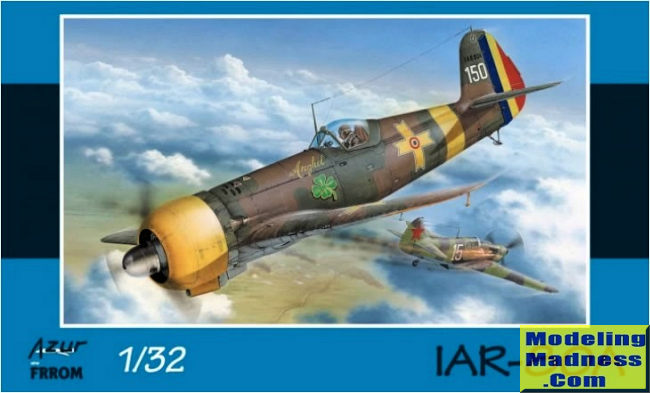
| KIT #: | FR 8002 |
| PRICE: | $ |
| DECALS: | Four options |
| REVIEWER: | Scott Van Aken |
| NOTES: | New tool kit with resin and etched parts |

| HISTORY |
The IAR 80 was a Romanian World War II low-wing, monoplane, all-metal monocoque fighter and ground-attack aircraft. When it first flew, in 1939, it was comparable to contemporary designs such as the German Messerschmitt Bf 109B, the British Hawker Hurricane Mk.I, and the American Curtiss P-40B/Tomahawk Mk.I and superior to the Dutch Fokker D.XXI and Polish PZL P.24. However, production problems and lack of available armament delayed entry of the IAR 80 into service until 1941. It remained in front-line use until 1944.
Production of the IAR 80 started immediately after the initial batch of 100 was ordered in December 1939, although the armament proved to be a serious problem. The prototype had mounted only two Belgian-made Fabrique Nationale 7.92 mm machine guns, a licensed modification of the Browning .30 cal. This armament was not heavy enough against modern aircraft, and the production model was expected to mount six. The German invasion of Belgium in 1940 suspended the supply from FN, and there was no suitable replacement. Lacking armament, production was halted. The Germans only allowed the delivery of the guns to resume after Romania joined the Axis in November 1940. As a result the first production IAR 80 didn't roll off the line until January 1941, although the first batch of 20 were delivered by the middle of February. The armament supply remained inadequate so production models only carried four guns.
The initial batch of fighters was well received by the Romanian pilots, but they found the aircraft underpowered and lacking firepower. In order to address this, the aircraft mounted the 960 hp (720 kW) K14-IV C32 engine in the 21st through 50th examples, but the firepower concern could not be resolved at the time.
By April 1941 the Romanians were firmly in the German sphere, and as a result the Germans released more FN guns for their use. These were quickly installed, and the resulting 80A model finally mounted the original complement of six guns. Armored glass in the windscreen, seat-back armor, and a new gun sight were also added at the same time, along with the newer 1,025 hp (764 kW) K14-1000A engine. The extra engine power proved to be more than the fuselage structure was designed to handle, and it had to be reinforced with a duralumin "belt" just behind the cockpit in the first 95 A series aircraft built before the fuselage could be modified.
Although the IAR 80A had a more powerful engine, the added weight of the guns, ammunition and armor plating reduced the top speed slightly to 316 mph (509 km/h). Nevertheless the new model was clearly an advancement, and the A model replaced the earlier one on the assembly line starting with the 51st airframe. Eight of these had been completed in time for the invasion of the Soviet Union on 22 June 1941.
FN guns remained in short supply, so throughout late 1941 and early 1942, guns were stripped from PZLs and observation aircraft for use in the IARs.
| THE KIT |
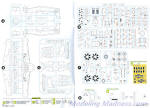 Back
in 2014, Frrom produced their first 1/32 kit, the IAR-81C. s first venture into 1/32 scale and they picked a perfect example in
the IAR-81C. For those unaware, Frrom tends to concentrate on Romanian subjects
with help from Azur in developing the kits.
Back
in 2014, Frrom produced their first 1/32 kit, the IAR-81C. s first venture into 1/32 scale and they picked a perfect example in
the IAR-81C. For those unaware, Frrom tends to concentrate on Romanian subjects
with help from Azur in developing the kits.
Molded as you would expect a kit from the CMK family of short
run kits, the detailing on this one is superb. Finely engraved panel lines that
are not too deep and are quite crisply done. I did find a touch of flash and a
couple of the thicker parts had sink areas that will need to be filled.
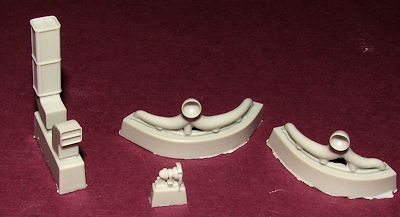 There are
also some ejector towers that you may wish to remove before construction. These
are on the larger pieces. The kit comes of six grey plastic sprues with a clear
sprue for the canopy, windscreen, wing tip lights, and reflector glass. None of
the part numbers are printed on the sprues so one will be continually referring
to the sprue diagrams when building the kit. Resin is used for the exhaust, gun
sight, gun barrels (not shown) and the carb intake, offering a standard and filtered piece.
There are
also some ejector towers that you may wish to remove before construction. These
are on the larger pieces. The kit comes of six grey plastic sprues with a clear
sprue for the canopy, windscreen, wing tip lights, and reflector glass. None of
the part numbers are printed on the sprues so one will be continually referring
to the sprue diagrams when building the kit. Resin is used for the exhaust, gun
sight, gun barrels (not shown) and the carb intake, offering a standard and filtered piece.
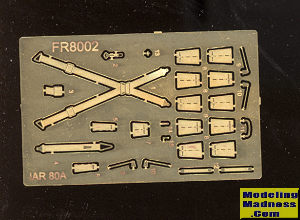 A nice photo
etch fret is also provided containing a seat harness, canopy grab handle,
elevator trim tab control hinges, rudder foot straps, and cowl flaps. Frrom
could have done a much more extensive set, but decided to do a lot of the very
small pieces using injected plastic instead and I am pleased at their choice of
material as I'm sure many other modelers will be. This does bring up a down side
in that I found several thin pieces already broken on the sprues. The location
of the sprue attachment points on these thin pieces means that even more will be
broken simply removing them. It is rather standard stuff for kits of this nature
and why they are recommended for experienced modelers.
A nice photo
etch fret is also provided containing a seat harness, canopy grab handle,
elevator trim tab control hinges, rudder foot straps, and cowl flaps. Frrom
could have done a much more extensive set, but decided to do a lot of the very
small pieces using injected plastic instead and I am pleased at their choice of
material as I'm sure many other modelers will be. This does bring up a down side
in that I found several thin pieces already broken on the sprues. The location
of the sprue attachment points on these thin pieces means that even more will be
broken simply removing them. It is rather standard stuff for kits of this nature
and why they are recommended for experienced modelers.
With such a large scale to work with, one will not be surprised that there is a ton of detail. The cockpit has a lot of this with the various framework pieces, a very well done seat, floor, armor plating, trim wheels and instrument panels. Decals are provided for instruments. There is also quite a bit of sidewall detail with various control levers and knobs. I found it interesting that the interior color for this aircraft is a light blue grey rather than some sort of greenish shade. This color is also used in wheel wells and inside of gear doors.
Speaking of gear doors, each one is separate and has separate pieces that are used to attach them to the gear struts. The gear themselves are superbly molded with separate oleo scissor sections and a nicely done retraction strut. The tail gear is a skid type.
Wings are a single lower pieces to set the proper dihedral with separate upper halves. All the control surfaces are separate. The ailerons have separate hinges and the flaps can be displayed lowered if one wishes. Looking at a lot of period photos, there was not 'standard' position for the flaps as I found images of them parked with them both up and down. Elevators and rudder are also separate.
The kit has a superbly done engine that is a model in its own right. There are separate pushrods as well as a very complex engine intake and exhaust piping arrangement. You'll be spending quite a bit of time on this part of the build and it is a shame to have to hide much of it in the cowling. The cowling itself is two halves with a single forward section so no worries on seams. The cowling has separate cowl flaps and the instructions show exactly where these fit.
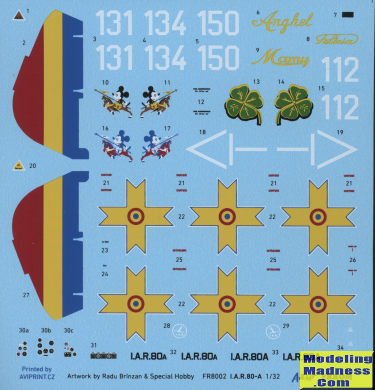
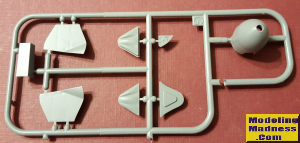 There
are differences between the previous IAR-81C and this kit. Those include a
shorter fuselage, shorter wings, one wing mounted oil cooler (from aircraft
#251), more guns, no tail struts. This kit is typical of aircraft above #95.
There is an additional sprue with some of the new bits, including a longer
spinner.
There
are differences between the previous IAR-81C and this kit. Those include a
shorter fuselage, shorter wings, one wing mounted oil cooler (from aircraft
#251), more guns, no tail struts. This kit is typical of aircraft above #95.
There is an additional sprue with some of the new bits, including a longer
spinner.
Instructions are a bit on the busy side with well drawn construction steps and for the first time, there is color on every page of the instruction booklet. Paint references are Gunze with generic, RLM and FS 595 references given where appropriate. Four markings options are provided, all of which are Dark Green and Dark Earth over Sky Blue with the usual yellow theater bands. Three of the options are from Escadrila 47 which has a four leaf clover unit marking and the other is from Escadrila 53 with a red rudder and mounted Mickey Mouse badge. Decals are superbly printed by AviPrint and are quite thin.
| CONCLUSIONS |
Apparently the IAR-81C sold well enough for Azur/FRROM to produce the earlier version. It is great to see this one available as it is what most people think about when 'IAR-80' is mentioned. I built the IAR-81C kit and it makes into a superb model.
| REFERENCES |
http://en.wikipedia.org/wiki/IAR-81
January 2018
Thanks to Gilles Fontaine of Frrom
for the preview kit. It should be available in stores very soon. Visit
www.frrom.com for more information. If you would like your product reviewed fairly and
fairly quickly, please
contact
the editor or see other details in the
Note to
Contributors.